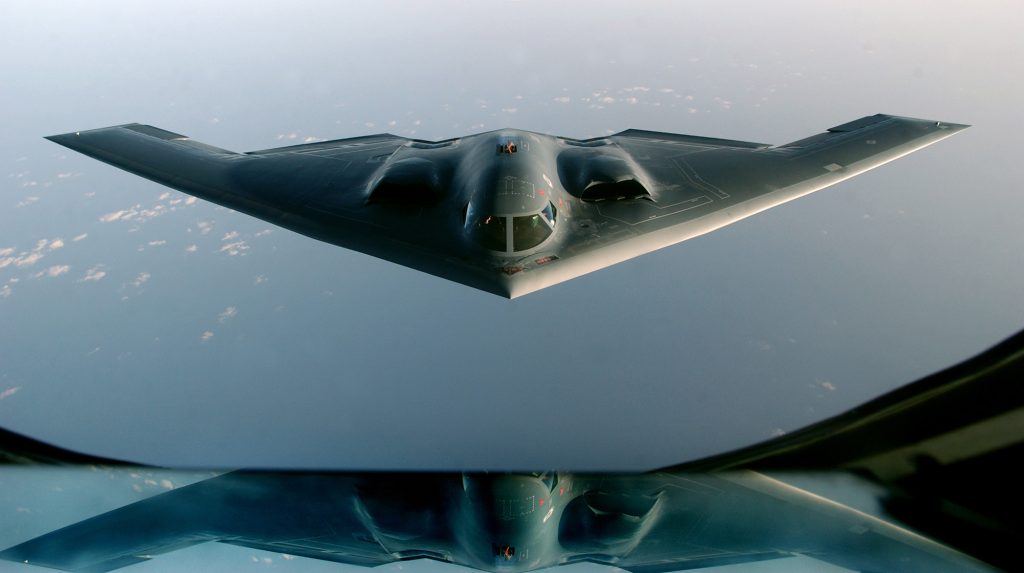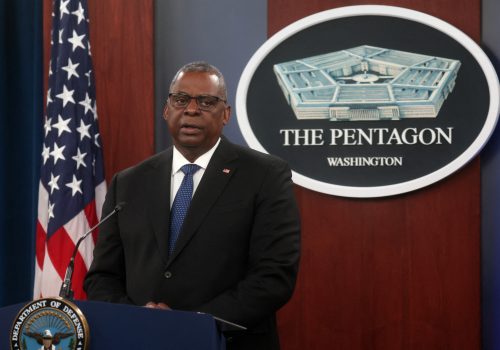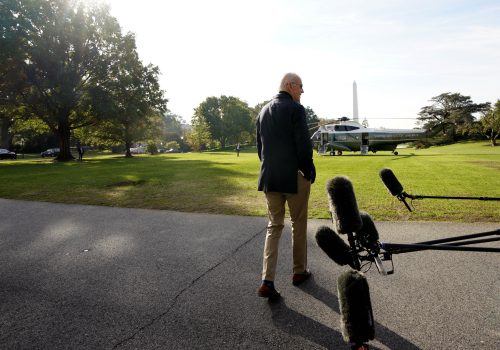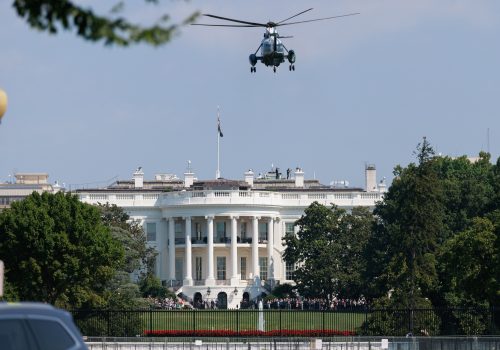The Biden administration’s recently released Nuclear Posture Review (NPR) depicts a new nuclear era taking form. As Richard Johnson, deputy assistant US secretary of defense for nuclear and countering weapons of mass destruction policy, described it at an Atlantic Council event Tuesday where the Department of Defense rolled out the review, the United States is now “facing potentially the rise of two nuclear-armed competitors” for the first time.
By focusing on the problems posed by two nuclear peers, the review “nailed the strategic environment” and has shown that the world is “moving beyond the post-Cold War period,” said Robert Soofer, a former deputy assistant secretary of defense for nuclear and missile defense policy.
A pillar of post-Cold War nuclear arms control, the New START arms-reduction treaty between the United States and Russia is set to expire in 2026. Given that looming deadline, Alexandra Bell—deputy assistant secretary at the Department of State’s Bureau of Arms Control, Verification, and Compliance—said that the administration will need to think about how to face a scenario in which there are “potentially no constraints over the… largest nuclear arsenals in the world.” If that happens, “for the first time in over fifty years, it’s not a safer world.”
Below are other highlights from the event hosted by the Scowcroft Center for Strategy and Security’s Forward Defense practice, which saw current and former Department of Defense, State, and Energy officials outline the top takeaways from the new NPR.
The newcomer on the block
- According to the NPR, China is set to join the ranks of the world’s biggest nuclear powers by accumulating one thousand warheads by 2030; but it isn’t just the number of warheads that should be concerning, according to Walter Slocombe, a former undersecretary of defense for policy. He pointed out China’s concerning moves “towards, in effect, a triad” with which it can launch nuclear weapons from land, sea, and air. Slocombe added the worrying “possibility of [China and also Russia] using nuclear weapons for coercion” in order to deter the United States and its allies from pursuing their interests. He explained that this coercion could, hypothetically, look like restrictions on the West’s aid to Ukraine or response to a Taiwan invasion.
- Bell explained that the United States doesn’t “understand where China is going with this” expansion of its nuclear arms, and that the administration has tried to engage with Beijing on arms control—but bilateral talks haven’t panned out. “It is sort of surprising given that China signed up to the [Treaty on the Non-Proliferation of Nuclear Weapons] and the same commitments that the United States has,” she said.
- “If they don’t want to have a discussion in the bilateral channel, there [are] other ways that China can demonstrate to us that they’re not pursuing things that we think that they are,” Johnson said. For example, he explained that the United States is concerned to see the construction of two fast breeder reactors in China, from which plutonium can be extracted for use in nuclear weapons. “It would be good for them to demonstrate that they’re not intending to divert it to military purposes,” Johnson said. “And right now, that doesn’t require any talks at all.” Rather, it could be achieved through the International Atomic Energy Agency (IAEA).
- Rather than insisting on limiting the sheer number of arms, Johnson said that the Biden administration wants to reduce risk across the board—with channels of communication, information exchanges, and military deconfliction. “Let’s talk [with Moscow and Beijing] about putting some guardrails into the relationship so that we don’t have unnecessary crises and the risk of miscalculation when things happen in [their regions],” he said.
Assurances for US allies
- After then presidential candidate Joe Biden wrote in a 2020 Foreign Affairs essay that “the sole purpose of the US nuclear arsenal should be deterring—and, if necessary, retaliating against—a nuclear attack,” a number of US allies worked to sway him otherwise. Johnson said that Biden only intended to pursue that direction “upon the consultations of our allies and partners and with the US military,” which Johnson described as “nuclear speed dating.”
- Johnson added that at the end of the policy review, the administration found that there is a “narrow range of high-consequence attacks” that could affect US allies and partners; thus, the Biden administration adopted a policy that only allows nuclear use in the most “extreme circumstances” in which vital US and allied interests are threatened.
- Johnson explained that moving toward the sole-purpose concept is still the administration’s goal, but it will have to “identify concrete steps to do that and work with our allies and partners to get there.” Bell commended the NPR for reflecting Biden’s eventual goal, but also “taking into account the security environment we’re currently in,” with Russia’s rising threats and China’s expanding capabilities.
What’s changed—and what hasn’t
- Matthew Kroenig, acting director of the Atlantic Council’s Scowcroft Center for Strategy and Security and former nuclear-weapons expert in the Department of Defense and intelligence community, explained that the United States has never had a “no first use” policy, and the NPR is following previous administrations by keeping options open. Leonor Tomero—a former deputy assistant secretary of defense for nuclear and missile defense policy—also pointed to the continuity with previous administrations in capabilities, including continuing to field the W76-2 thermonuclear warhead that was introduced during the Trump administration. The NPR is “coming out strong in favor of the nuclear modernization program of record,” she explained.
- However, the Biden administration canceled the nuclear-armed Sea-Launched Cruise Missile Program launched in the 2018 NPR. Soofer, who served in the Trump administration, explained that the program was designed to establish a nuclear presence in Asia and elsewhere without having to ask allies to host weapons. That presence “improved the survivability of our sea-based leg” of the nuclear triad. By taking it away, Soofer argued, the Biden administration is “taking away an option to deal with this two-nuclear-peer problem.”
- In contrast, Tomero pointed out that the program “hadn’t even started development in earnest” so this “really wasn’t a real capability yet.” Johnson said that the Biden administration feels “like we have the capabilities we need to deter… nuclear use,” including a possible tactical strike by Russia, without the Sea-Launched Cruise Missile Program. “We think it has marginal capability when added to all those other capabilities.”
- While weapons and capabilities are “very critical,” Cindy Lersten, director of the office of policy and strategic planning at the Department of Energy’s National Nuclear Security Administration (NNSA) said that “nonproliferation, counterterrorism, and arms control” are what create this NPR’s “comprehensive and balanced approach.” According to Johnson, these are all areas in which the administration wants to “regain the leadership role” to avoid nuclear war.
Diving deeper
- Tomero noted that the NPR’s approach to North Korea is another “good area of continuity” from the Trump administration. Slocombe called the NPR’s section on North Korea “absolutely bloodthirsty” in saying that any nuclear attack from Pyongyang would result in the end of Kim Jong-Un’s regime. That is a “good message to send to the North Koreans,” Slocombe added. But not everyone: Kroenig explained that there is no “one size fits all deterrence policy,” so “the way we deter Russia is different from the way we deter North Korea.”
- In contrast, Slocombe pointed out that the NPR’s approach to Iran is much more “low key,” with the aim of keeping Tehran’s nuclear exploration “from being a problem” as negotiations continue to revive the country’s 2015 nuclear deal. With Iran reaching uranium enrichment levels of 60 percent, nearing the 90 percent that is considered weapons grade, Lersten said that the United States will continue to rely on the IAEA to monitor and provide insight into Iran’s nuclear activities. Johnson added that via the IAEA, the United States should be able to detect any moves to increase enrichment levels.
- The Biden administration will next need to contend with “increasing resilience” and “making ourselves less vulnerable to attack” in order to maintain credible deterrence, Tomero said. “That needs to be fleshed out a lot more.”
- Lersten pointed to the NNSA’s plans to modernize nuclear capabilities and infrastructure that will see the retirement or refurbishing of older weapons and the introduction of new, higher-precision and lower-yield capabilities—all of which could improve resilience. “Our number one priority [is] to make sure that our nuclear stockpile is safe, secure, and effective,” she said.
Watch the full event
Further reading
Thu, Oct 27, 2022
Eight things you need to know about the new US National Defense Strategy
New Atlanticist By
Does the strategy succeed? We turned to our experts to break down the Pentagon's plans.
Wed, Oct 12, 2022
Experts react: The hits and misses in Biden’s new National Security Strategy
New Atlanticist By
We put the call out to our experts from across the Atlantic Council: Does this document deliver? What does it get right and what’s missing?
Fri, Oct 14, 2022
Scowcroft Strategy Scorecard: What grade does Biden’s National Security Strategy get?
Scorecard By
Our strategy experts praised the document for being clear-eyed about the challenges posed by Russia and China, but downgraded it for a lack of focus as well as concerns about how to implement its ambitious aims.
Image: A B-2 Spirit proceeds to an undisclosed location after flying a mission over Iraq, March 27, 2003. Photo via REUTERS/Cherie A. Thurlby/U.S. Air Force



